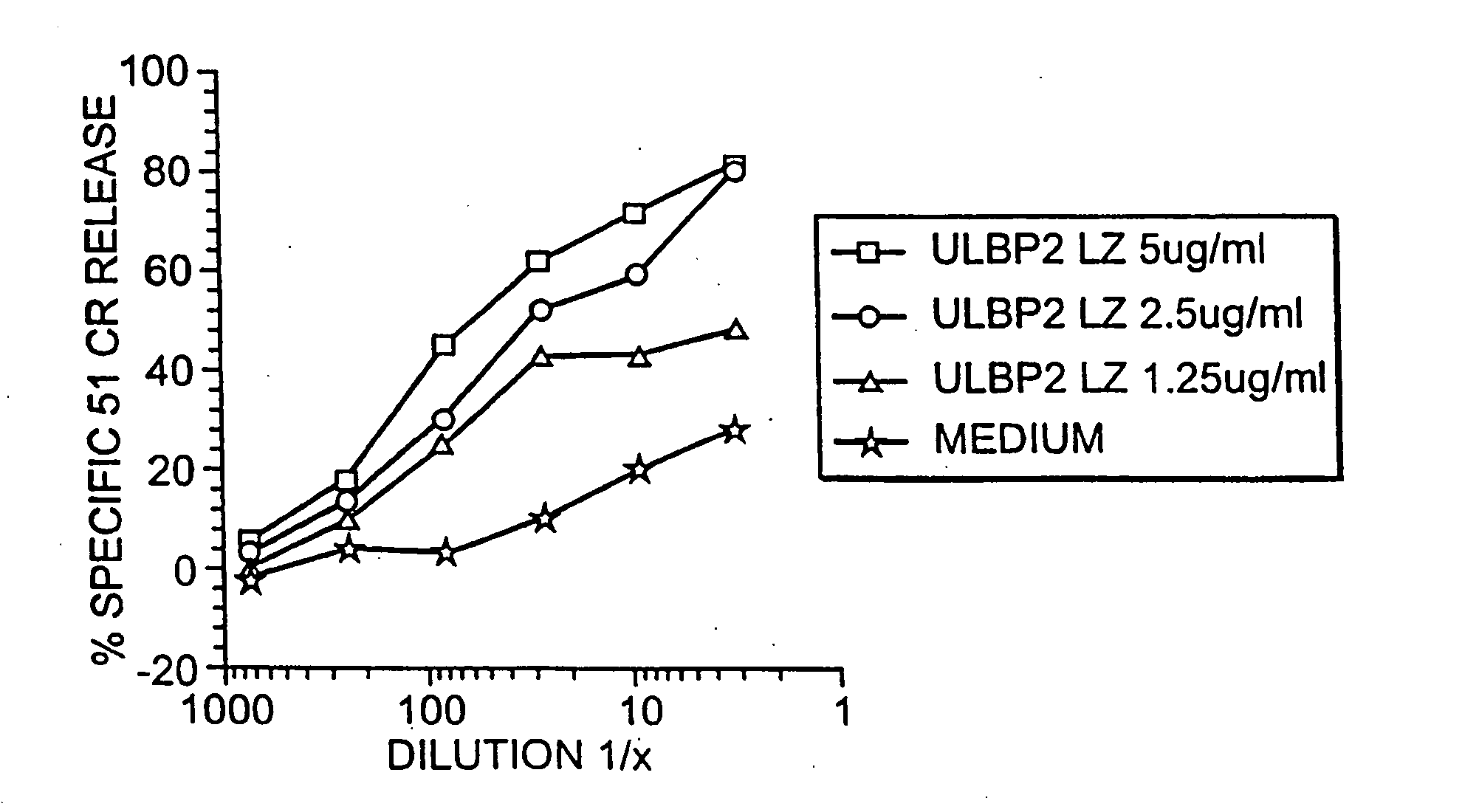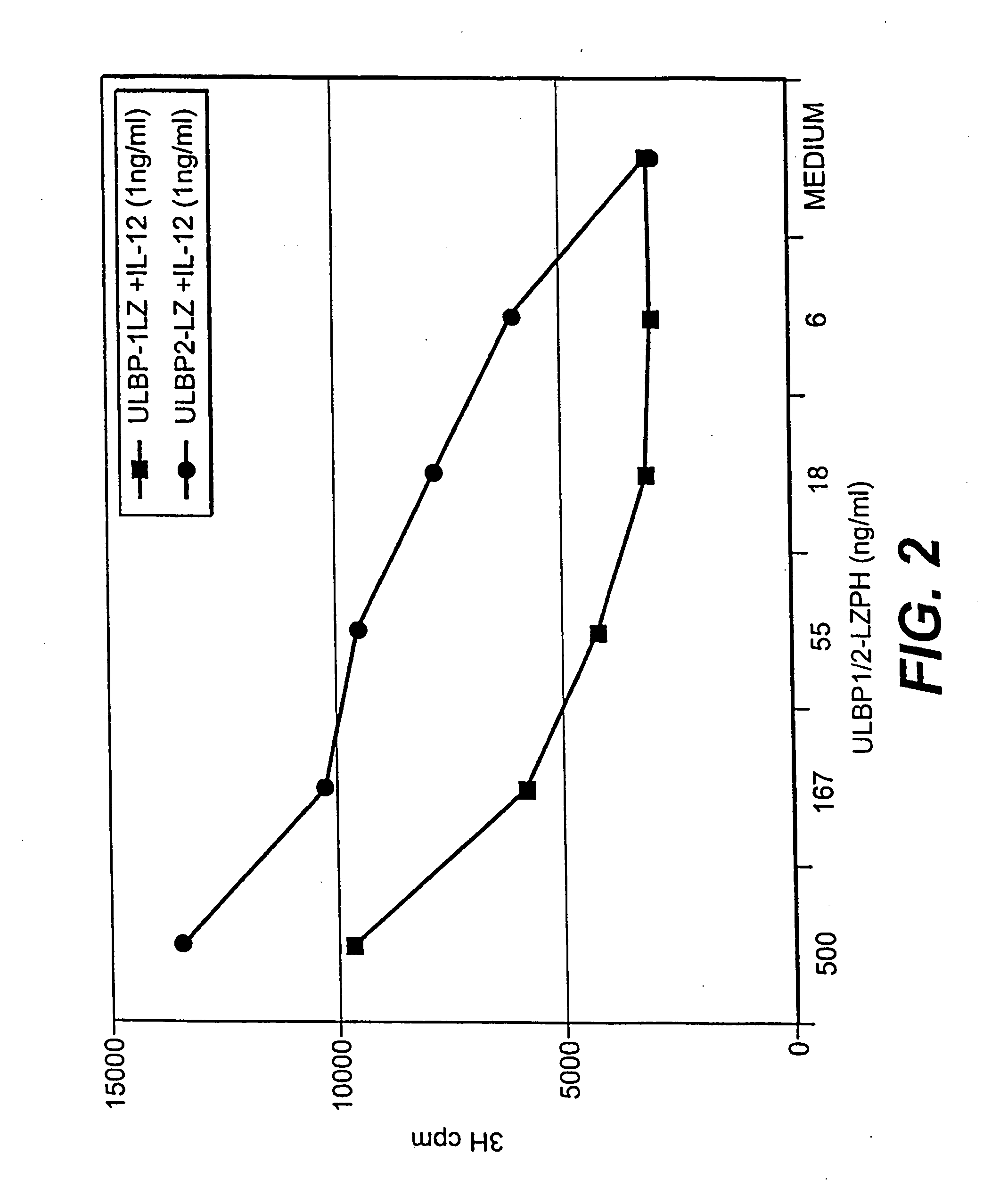ULBP antibodies
a technology of ulbp and antibodies, applied in the field of ulbp antibodies, can solve the problems of increasing the frequency of elevated marker levels, most markers have been found to lack sufficient specificity for such applications, etc., and achieve the effects of increasing ifn- production, increasing nk cell proliferation and activation, and increasing ctl activity
- Summary
- Abstract
- Description
- Claims
- Application Information
AI Technical Summary
Benefits of technology
Problems solved by technology
Method used
Image
Examples
example 1
Recombinant Expression of Human ULBP-1
[0323] A human ULBP1-Fc construct was generated in the following manner. ULBP-1 DNA encoding the extracellular domain of human ULBP-1 polypeptide (residues 1-218) was generated by PCR using an upstream primer containing an XhoI site (5′-GCAACTCGAGAGCTCCAGGTCTACAATGGCAG-3′) and a downstream primer containing a BglII site (5′-GATGAGATCTGGGTTGGGTTGTGCCTGGGGCCAG-3′). The human ULBP-1 DNA fragment was cloned in frame into the pDC409 vector containing a 5′ SalI site and the human immunoglobulin Fc region mutein (described in EMBO J. 13:3992, 1994) preceded by a BglII site.
[0324] The human ULBP1-Fc fusion polypeptide was produced and purified as described in Fanslow et al., J. Immunol. 149:655, 1992, which is incorporated by reference.
[0325] The human ULBP1-LZ fusion polypeptide was produced using the expression vectors, transfection, and cell culture procedures used for the ULBP1-Fc polypeptide. For purification, the poly His tag is used to bind th...
example 2
Recombinant Expression of Human ULBP-2
[0326] A human ULBP2-Fc construct was generated in the following manner. ULBP2-DNA encoding the extracellular domain of human ULBP-2 polypeptide (residues 1-223) was generated by PCR using an upstream primer containing an XhoI site (5′-GATTCTCGAGTCCTTAATGGCAGCAGCC-3′) and a downstream primer containing a BamHI site (5′-ACAAGGATCCCCTGAGTTGGGTTGTGCC-3′). The human ULBP-1 DNA fragment was cloned in frame into the pDC409 vector containing a 5′ SalI site and the human immunoglobulin Fc region mutein (described in EMBO J. 13:3992, 1994) preceded by a BglII site.
[0327] The human ULBP2-Fc fusion polypeptide was produced and purified as described in Fanslow et al., J. Immunol. 149:655, 1992, which is incorporated by reference.
[0328] The human ULBP2-LZ fusion polypeptide was produced and purified as described above for the ULBP1-LZ fusion polypeptide.
example 3
Preparation of Antibodies Against ULBP-1
[0329] Monoclonal antibodies were generated against ULBP-1. Balb / c mice were immunized with 10 μg of ULBP1-Fc (1 mg / ml stock, batch #1) in Titermax adjuvant (CytRx Corp., Norcross, Ga.). The animals were boosted 2 weeks later with 10 μg of the same protein in Freunds Complete Adjuvant (Sigma). Twelve weeks after second immunization, one mouse was boosted intravenously with 10 μg of ULBP1-Fc (Batch #3) in saline. Four days later, the mouse was sacrificed and spleen and lymph nodes were fused with NS1 myelomas with 50% PEG / DMSO solution. The fused cells were placed into 96 well plates (Costar) with HAT (Sigma) selective media. Hybridoma supernatants were screened for antibody production by antibody capture assay (ABC). Briefly, 96 well plates (Nunc) were coated overnight with goat-anti-mouse IgG Fc specific (Pierce), then washed 4 times with PBS. Supernatants were incubated 1 hour at room temperature then washed 5 times with PBS. ULBP1-Fc was a...
PUM
| Property | Measurement | Unit |
|---|---|---|
| pH | aaaaa | aaaaa |
| temperature | aaaaa | aaaaa |
| pH | aaaaa | aaaaa |
Abstract
Description
Claims
Application Information
 Login to View More
Login to View More - R&D
- Intellectual Property
- Life Sciences
- Materials
- Tech Scout
- Unparalleled Data Quality
- Higher Quality Content
- 60% Fewer Hallucinations
Browse by: Latest US Patents, China's latest patents, Technical Efficacy Thesaurus, Application Domain, Technology Topic, Popular Technical Reports.
© 2025 PatSnap. All rights reserved.Legal|Privacy policy|Modern Slavery Act Transparency Statement|Sitemap|About US| Contact US: help@patsnap.com



